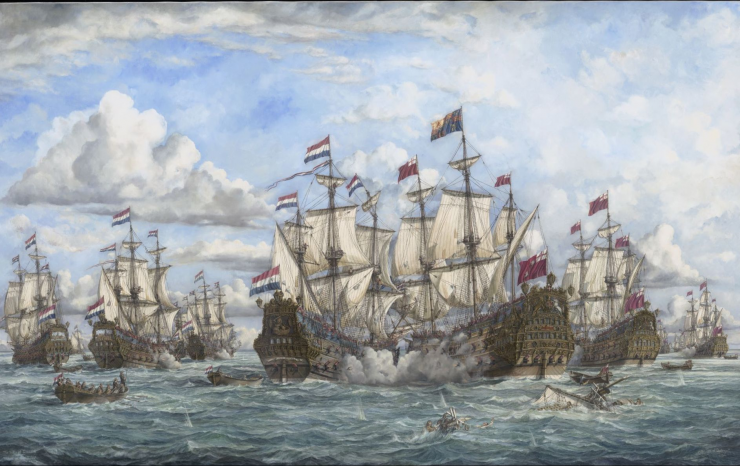On 11 June Van Wassenaer sighted the English fleet but there was a calm and no battle could take place. On 12 June the wind again started to blow—and from the east, giving Van Wassenaer the weather gage. However, he simply didn't attack, despite clear orders to do so under these conditions. Next morning the wind had turned to the west and now he approached the enemy fleet.
In the early morning of the 13th the Dutch fleet was positioned to the southeast of the English fleet. Both fleets passed in opposite tack and then turned. After this there was a second pass. The Dutch now completely failed to maintain a line of battle. Again both fleets turned. Apart from these positional problems, The Dutch had a structural disadvantage: on average their guns were much lighter. Especially the eight largest English vessels were almost unsinkable themselves but could wreck the smallest Dutch ships with a single broadside. The larger Dutch vessels therefore tried to protect the little ones. The Dutch flagship Eendracht dueled the Royal Charles. James was nearly killed by a Dutch chain-shot decapitating several of his courtiers.
Around three in the afternoon the duel between the Royal Charles and the Eendracht ended abruptly when the Eendracht exploded, killing Van Obdam and all but five of the crew. Kortenaer was second in command; though fatally wounded, he hadn't died yet, and the other admirals were unaware of his condition. For hours the Dutch fleet was therefore without effective command. After the Eendracht had exploded, the English immediately became more aggressive, while many Dutch captains faltered: some Dutch ships already fled a little later, followed by Kortenaer's ship the Groot Hollandia, now commanded by Stinstra. This had a negative effect on Dutch morale.
By evening most of the Dutch fleet was in full flight, save for 40 ships or so under Vice-Admiral Cornelis Tromp and Lieutenant-Admiral Johan Evertsen, though 16 more ships were lost.
The English lost only one ship, Eight Dutch ships were sunk by the English; According to some the Oranje lost half of its crew of 400 before succumbing During the Dutch flight the English captured nine more ships: Hilversum, Delft, Zeelandia, Wapen van Edam and Jonge Prins; the VOC-ship Nagelboom and the merchants Carolus Quintus, Mars and Geldersche Ruyter. Tromp was captured but escaped. Eight older ships had to be written off later, as the costs of repair would have exceeded their value.
The outcome of the battle was partially caused by an inequality in firepower, but the Dutch had already embarked on an ambitious expansion program, building many heavier ships. The English failed to take advantage of their victory. They never managed an effective blockade of the Dutch coast and could not prevent the VOC-fleet from returning from the Indies (Battle of Vågen). The fleets, now much more equal in quality, met again at the Four Days' Battle in June 1666.

